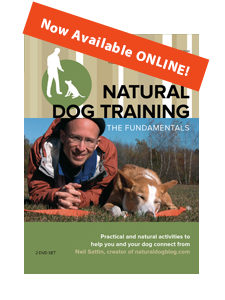I'm going to make a huge assumption here - you're reading this blog because you are interested in how your dog really feels the world, and you want to make sure that you have the happiest dog possible. You have recognized that some traditional ways of looking at your dog don't quite add up, and you want to get closer to being able to experiencing the world the way that your dog experiences the world. In this relatively brief article, we are going to talk about why it's important to keep your dog's feet on the ground. In case I'm not being clear, what I mean is: don't pick your dog up unless it's absolutely necessary.
These days so many of us have dogs that have become the "babies" of our families. And if our dog is our baby, then why not pick it up, coddle it, nuzzle it - just like we would with a newborn baby? If our dog is small enough to comfortably be carried around in our arms, why not carry it around in our arms? Won't that make it easier for our dog to interact with the human world - on the human level?
Dogs feel more secure when their feet are on the ground. That means that it will be easier for a dog to relax when all four paws are on the ground. We've talked quite a bit about why it makes more sense to be the calm and assertive "moose" in your dog's life (instead of the alpha dog), and we've also talked about a the way your dog's emotional experience of the world is the chief determining factor in terms of their behavior. Well, all of that emotional energy, just like electricity, needs to "flow to ground". That's the way that we natural dog trainers think about it, anyway.
Whether your dog is in a state of flow (relaxed, playing, being social) or a state of overload (aggression, submissive urination, crazy exuberance) - that energy is ultimately going to the ground. However, by being on the ground (or floor), there's much less opportunity for the high charge that leads to overload to build up - just like how if you were to be "grounded" you would be much less likely to pick up a static charge as you walk around your house on a dry winter day.
In addition, being on the ground gives your dog a much better chance of being able to physically adjust in order to handle the energy of any situation. Dogs are constantly changing their position in response to their environment in order to self-regulate the way that they're feeling (trying to stay relaxed and in the flow). When a dog is in our arms, suddenly that dog has no recourse - which becomes problematic when the energy of the situation becomes too much for them to bear. Our lovely little pomeranian is much more likely to get aggressive when greeting a stranger from the confines of our grasp. Being on the ground, on the other hand, gives little Sparky the opportunity to greet the world on his terms.
MANY children are bitten in the face because they pick a cute little dog up off the ground. Not long ago, I was asked about whether or not a certain breed of terrier could be cured of aggression towards children. A child had walked her cute little dog to the bus stop, where it was picked up off the ground and swarmed by a group of children - ultimately biting one of them. Er...and this was the dog's problem? Even if it had remained on the ground it would have been tough for that dog to handle the situation (really - what were the parents thinking?), but it might have had a chance (best scenario: it would have gotten free and run back home).
We'll be taking advantage of the dog-feels-more-secure-on-the-ground dynamic when we talk about how to train the down/stay (which is coming - but still a ways away). When your dog is relaxed and in contact with the ground (e.g. in a relaxed-and-energized down/stay), adding more energy to the system will actually create more magnetic force between them and the earth - they'll be rooted in their place. This position of contact with the ground actually reassures our dogs, and the ability to be simultaneously relaxed and energized in the down-stay position gives your dog a strategy for dealing with high energy situations on their own, when you're not around.
Next time you see someone else pick up their dog, take a good look at how the dog is responding. Does the dog seem happy to be there? Does the dog seem more relaxed than they were when they were on the ground? Is the dog more social with their paws off the floor, or are they making all sorts of submissive gestures (roughly translated: please put me down).
If you want to have a relationship with your dog where you're fulfilling your dog's doggiest desires, then start tapping into your dog's prey instinct. Lucky for you - that's what this entire blog is about! Save the babying for the human babies in your life - and put all of that pampering energy into pampering yourself. What your dog really wants is a nice walk through the park, a rousing game of tug-of-war where they get to win, and the satisfaction of food in their belly after expending some effort to get it. And to interact with the world on their own terms, which means having their feet on the ground - so they can approach or move away, whatever seems most appropriate to them. Our dogs are always right, after all.





Well, my dog used to be really really afraid of other dogs, understandably, at only 23lbs, no good defenses, her life was in danger especially if she is leashed, on the ground, underneath these towering pushy dogs. She learned to jump up on my back to get away from other dogs, and she relies on me to protect her, CHOOSING to jump up in my arms, or sometimes up on my back to get out of the way of where other dogs might be making her uncomfortable. She chooses this. It makes her feel a lot more secure.
Hi Jenny,
It certainly sounds like your dog has come up with a good way of negotiating contact with large, pushy dogs. However, your comment makes me think of Turid Rugaas, who talks about one of her dogs, a tiny dog, who was a MASTER of negotiating social situations with other dogs, even large, pushy, aggressive dogs. She also mentions that interacting with her dog was therapeutic for the other dogs, teaching them better ways of managing social situations.
So I like to try to get dogs to that stage, where they are in a hunting/social mode that allows them to negotiate their contact with other dogs in a way that feels safe and secure, while connecting with that dog in a way that feels good. It takes two to tango, though, so if the other dog is more interested in the fight, then maybe on your back is the safe place for her to be.
As long as the other dog doesn't take that as a cue to attack you instead! 🙂
Yes, I always say that some dogs need more time than others, my barbet isn't like my daughter's bichon, who is naturally a master of negotiations. My barbet has had to do a lot of work to develop confidence and social skills with dogs, so when the interaction is flying too fast (passing on a sidewalk), I'm not planning on hugging the human and she doesn't have to sniff the dog! When we have time, and the other dog/human has time, then absolutely, get down and friendly! The worry about another dog attacking is an excellent reason for all dog trainers to maintain some safe space around them and their dogs and not let any strange dog hurry into the point of contact. I can tell you story after story of exactly this situation which has resulted in the littler dog getting killed (little dog was on the ground). With a loose weird dog, by turning your back and walking away with small dog in arms, you can almost always avoid aggressive provocation. And if that doesn't work, the small dog didn't have a chance on the ground.
Of course now our conversation is moving on to something else entirely. I still stand by the original post, that dogs - all dogs - are more secure and able to negotiate social situations (with other dogs, humans, etc.) when all four paws are on the ground. Particularly this article is directed at people with toy breeds, to give them a sense of how coddling a dog and lifting it off the ground can feed anxiety. However, just keeping the dog on the ground might not be enough, you might have to work with a dog to help them learn the social skills that we're talking about.
As for "preventing attacks from wayward dogs" - that's a different conversation entirely. And I don't think that - unfortunately - one can make any universal statements about the "best" way to handle that situation. You can find just as many news reports of people scooping their dogs up to protect them, only to have them snatched literally from their arms.
Generally a dog that's coming after you (or your dog) is doing so because they're attracted to you - and the way that you handle it (and hope for the best) depends a lot on your temperament as a human. Not staring down/facing the dog is a good start, absolutely. Someone could simply try to keep themselves between the other dog and their dog - or could walk away as you suggested. But all of these strategies have their associated risks.
That's why I think your other statement - that owners should do their best to be aware of their surroundings, maintain "safe space", and do their best to control the flow of interactions with other dogs, is the best preventative approach.